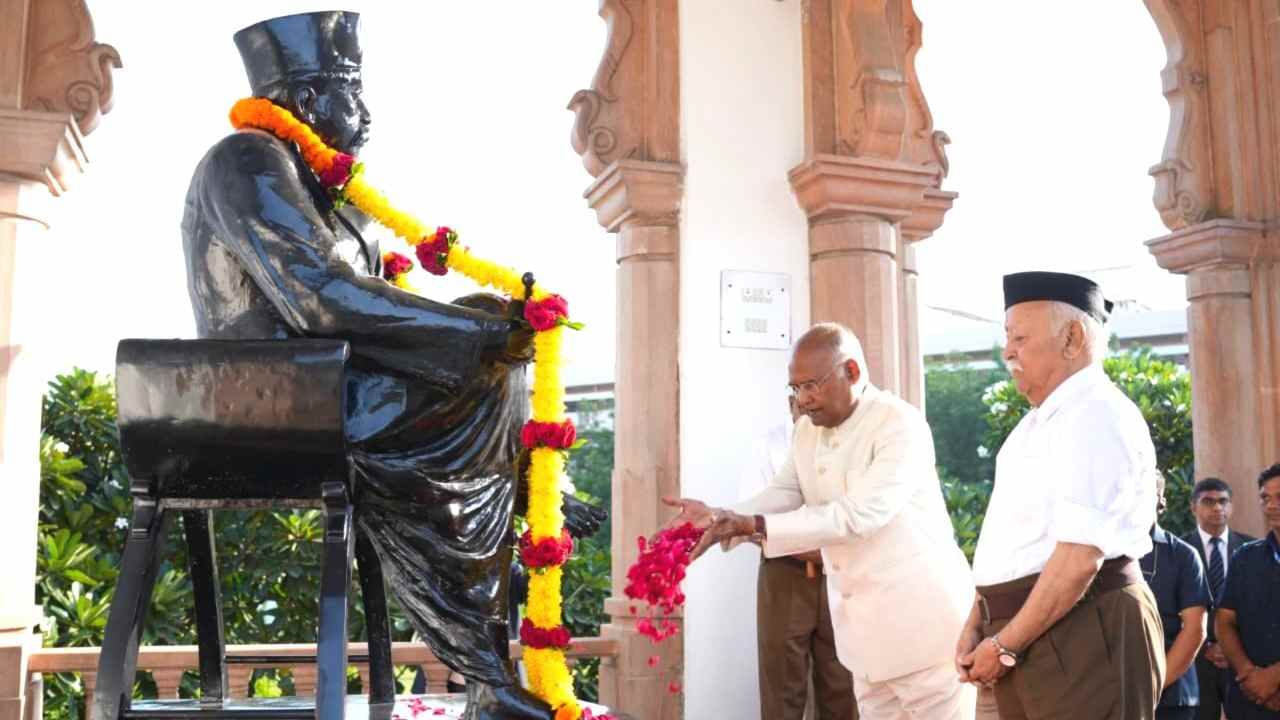Vijayadashami Utsav: Key Points of the Address by Chief Guest, Dr Ram Nath Kovind (Former President of Bharat).
• Today is also the birth anniversary of Mahatma Gandhi and former Prime Minister Shri Lal Bahadur Shastri. I bow with reverence to the memory of these great men.
• This day of the Vijayadashami Utsav is also the Centenary Festival of the Sangh. Today marks the completion of 100 years of the world’s largest voluntary organisation, which carries forward the most ancient culture of the world.
• Among the nation-builders, there are two doctors who played a very important role in shaping my life. These two great personalities are Dr Keshav Baliram Hedgewar and Dr Bhimrao Ramji Ambedkar.
• Through the profound thoughts of Dr Hedgewar, my outlook towards understanding an individual, society, and the nation has become clearer.
• On this day, I pay heartfelt homage to Dr Hedgewar, Guruji, Balasaheb Deoras, Rajju Bhaiya, and Sudarshan.
• The sapling of organisation planted and nurtured by Dr Hedgewar was expanded beautifully and given strong roots by Guruji.
• Balasaheb Deoras, while expanding the Sangh, laid special emphasis on harmony and social oneness.
•Rajju Bhaiya guided the Sangh during the major economic changes and the accompanying social transformations after independence.
•Sudarshan advanced the work of the Sangh amidst political transitions as well as social and moral changes.
• Dr Mohan Bhagwat, while being an unparalleled interpreter of Bharatiya traditions, is also a visionary social scientist who harmonises modernity with values.
• The Sangh is engaged in the noble task of connecting every section of society—farmers, scientists, students, entrepreneurs, tribals, healthcare workers, labourers, advocates, soldiers, artists, children, and the power of motherhood—through various dimensions.
• For the auspicious beginning of the Sangh, Dr Hedgewar chose not only the most sacred day but also the most meaningful day.
• By running an underground movement, the Sangh offered an effective resistance against the Emergency, which became a subject of global discussion.
• In the years 1948, 1975, and 1992, bans were imposed on the Sangh. But every time, amidst serious challenges, the Sangh expanded, evolved, and emerged stronger.
• The Sangh has no formal membership, yet such dedicated commitment as seen in its Swayamsevaks is rarely found anywhere else.
• The Sangh has always stood firmly for social unity and reform, and it has remained consistently active in this direction.
• I have observed that the Swayamsevaks of the Sangh give utmost importance to the continuity and unity inherent in Bharatiya traditions.
• From the revered Dattopant Thengadi, I received invaluable training in workers’ welfare and social service.
• In understanding constitutional values, the thoughts of Babasaheb Ambedkar, the chief architect of the Constitution, have acted like a guiding light illuminating my vision.
• On 25 November 1949, in his historic address in the Constituent Assembly, Babasaheb expressed some concerns which I find reflected in the concerns and contemplation of the Sangh as well.
• With his historical vision, Babasaheb exposed certain social weaknesses before the Constituent Assembly. These are expressed in an English proverb: “United, we stand. Divided, we fall.” Meaning, where there is unity, there is strength; where there is division, there is downfall. Dr Hedgewar also said that foreigners handed over sticks to our own brothers to torment us. We remained disorganised and divided.
• Today, in thousands of Shakhas, lakhs of Swayamsevaks are moving forward continuously with the goals of building personality, character, society, and the nation.
• I believe that every Bharatiya should recite the Sangh’s Ekatmata Stotra. This hymn contains the noblest expression of Bharatiya history, geography, culture, life-values, and social inclusiveness and harmony.
• Women are equal partners in our family system. This fact is also reflected in the journey of the Sangh. Around 90 years ago, on Vijayadashami, 25 October 1936, the Sangh established the ‘Rashtra Sevika Samiti.’
• Social equality and unity are the identity of the Sangh. Efforts like ‘One temple, one well, one cremation ground’ are helping remove divisive tendencies.
• Witnessing the atmosphere of harmony, equality, and caste-free conduct within the Sangh, Mahatma Gandhi was deeply impressed. A detailed account of this is found in the collected writings of Gandhi.
• In January 1940, Babasaheb Ambedkar visited a Sangh Shakha in Karad town, Satara district of Maharashtra. There he met people, expressed a sense of belonging, and even offered help. This is a historical testimony to the Sangh’s harmonious philosophy and inclusive conduct.
• On 9 January 1940, the Kesari newspaper quoted an important statement from Babasaheb. He said, “Even though there are differences on some matters, I look upon this Sangh with a sense of belonging.”
• In his own weekly newspaper Janata, it was also reported that after participating in a programme of Karad Municipality, Babasaheb met the Swayamsevaks of the Sangh and assured them of his support whenever needed.
• Promoting economic self-reliance and Swadeshi has always been a priority of the Sangh.
• I believe that during the centenary year of the Sangh, the Panch-Parivartan programme’s Environmental Protection campaign will prove helpful in expanding a lifestyle harmonious with nature.
• It is encouraging to see that the attraction of youth towards the Sangh is growing today.
• In the Panch-Parivartan programme of the Sangh, Civic Duties is also included. We, the people of Bharat, have taken a constitutional pledge to uphold social justice. By working with the goal and spirit of Antyodaya, we shall be able to truly fulfill our civic responsibilities.
• The working style of the Sangh is not person-centric but organisation-centric and principle-centric. This is the true strength of the Sangh.
• During the last hundred years, the Sangh has made tireless efforts for building a harmonious, organised, and inclusive society and for creating a strong nation.
• I firmly believe that by the year 2047, in building a developed Bharat and a fully harmonious and integrated Bharat, the Sangh will continue to have an immeasurable contribution.
